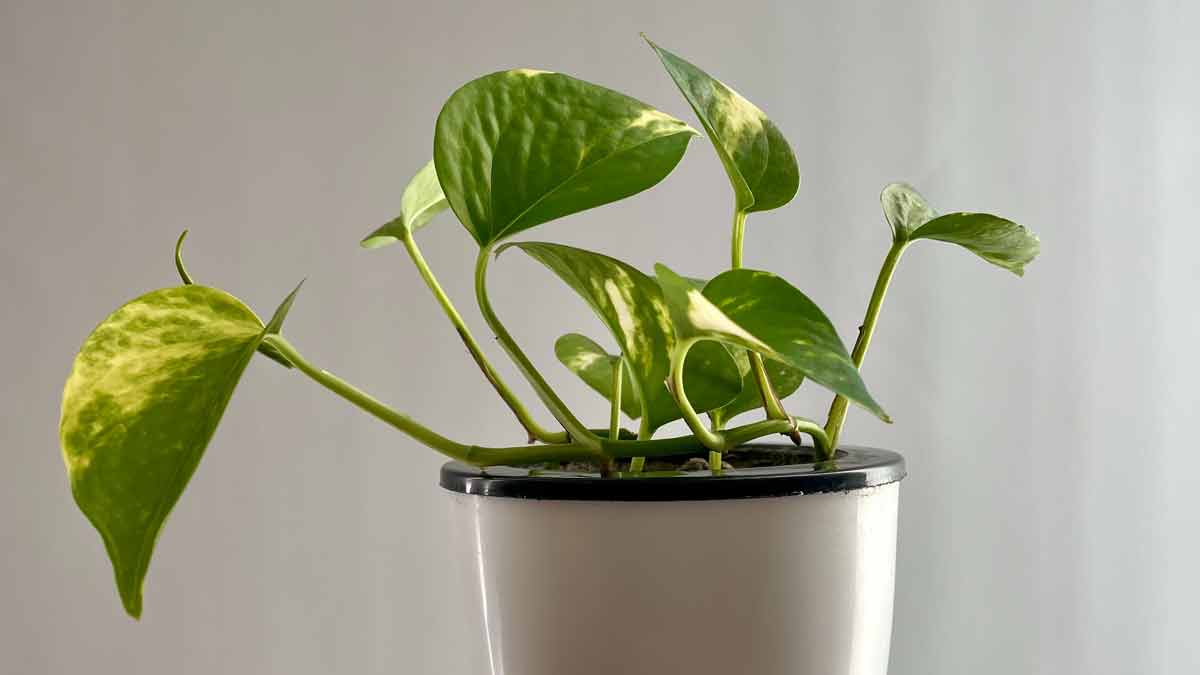Pothos plants, also known as devil’s ivy, are very popular houseplants. They are easy to care for and can tolerate a wide range of conditions.
However, pothos plants can sometimes experience problems, including leaves falling off.
Although it may be alarming to see pothos leaves falling off, it is not a cause for concern in most cases.
This article will discuss why pothos leaves may fall off and how to fix the problem.
What Causes Pothos Leaves To Fall Off
There are several reasons why pothos leaves may fall off.
The most common reasons and how to fix them are as follows:
1. Overwatering
Pothos leaves often fall off due to overwatering, a common issue. These plants prefer moist soil but should not be waterlogged. Excessive moisture can lead to root rot, which can be fatal for the plant.
To remedy an overwatered pothos, avoid frequent watering. Instead, let the top inch of soil dry out before you water it again. Typically, pothos plants should be watered about once a week.
2. Underwatering
Pothos plants can also suffer from leaves falling off if they are not watered enough. Underwatered pothos plants will have wilted, dry leaves, and yellow or brown. The pothos leaves may also be drooping.
If you think your pothos plant is not watered enough, check the soil to see if it is dry. If it is, water your plant and see if the leaves start to perk back up. If the leaves do not improve, you may need to repot your plant in fresh soil.
3. Extreme Temperature Changes
Pothos plants are native to tropical regions and prefer warm temperatures. However, they can tolerate a wide range of temperatures.
When pothos plants experience extreme temperature changes, such as moving from a warm room to a cool one, it can cause their leaves to fall off.
To fix this problem, try to keep your pothos plant in a room that has consistent temperatures. If you need to move your plant, do so slowly so it can gradually adjust to the new temperature.
Pothos plants thrive in temperatures that are between 60°F and 80°F (15°C – 26°C).
4. Nutrient Deficiencies
Pothos plants can also suffer from leaves falling off if they are not getting the nutrients they need. They need a balanced fertilizer high in nitrogen, phosphorus, and potassium.
If you think your pothos plant is not getting enough nutrients, try watering it with a diluted fertilizer solution.
You can also add some compost to the soil to help improve its nutrient content.
5. Not Enough Light
Pothos plants need bright indirect light to thrive. If they are not getting enough light, their leaves may start to turn yellow and fall off.
Try moving your pothos plant to a brighter location to fix this problem. However, ensure that the new site does not get direct sunlight, which can scorch the leaves.
Placing your pothos plant near an east- or a west-facing window is a good option. This will provide bright, indirect light without exposing the plant to direct sunlight.
6. Too Much Sunlight
Although pothos plants need bright light to thrive, too much sunlight can cause their leaves to fall off. If the leaves are exposed to direct sunlight, they can become scorched and turn brown or yellow.
If you think your pothos plant is getting too much sunlight, try moving it to a location with more indirect light.
You can also try placing a sheer curtain over the window to filter out some of the sunlight.
7. Soil Issues
The quality of the soil can also affect pothos plants, and poor-quality soil can cause their leaves to fall off. Pothos plants prefer well-draining, sandy soils.
The roots may become waterlogged and rot if your pothos plant is in a pot with poorly draining potting soil. This will eventually kill the plant.
Try repotting your pothos plant in a pot with fresh, well-draining soil to fix this problem.
To improve drainage, you can also add some perlite or pumice to the potting mix.
8. Pests
Pests can also cause pothos plants to lose their leaves. The most common pests that affect pothos plants are mealybugs, spider mites, and aphids.
These pests suck the sap from the leaves, which can cause the leaves to fall off.
If you think your pothos plant has pests, check the leaves for any insects or egg sacks. You can also look for webbing or stippling on the leaves.
You can try spraying your pothos plant with insecticidal soap or neem oil solution to eliminate pests. You can also introduce beneficial predators, such as ladybugs, into your home.
9. Diseases
Diseases can also cause pothos leaves to fall off. The most common diseases that affect pothos plants are root rot, bacterial leaf spot, and powdery mildew.
Root rot is caused by a fungus that attacks the pothos roots. This can cause the roots to rot and the leaves to fall off.
Bacterial leaf spot is caused by bacteria that infect the pothos leaves. This can cause the leaves to turn yellow or brown and eventually fall off.
Powdery mildew is a fungal disease that affects pothos plants. It causes white, powdery spots to appear on the leaves. This can eventually cause the pothos leaves to turn yellow and fall off.
To prevent diseases, make sure you are not overwatering your pothos plant. Sterilizing your pruning shears before using them on your pothos plant is also a good idea.
If you think your pothos plant has a disease, you need to remove any affected leaves. You should also quarantine the plant to prevent the disease from spreading.
You can treat most diseases with a fungicide or bactericide.
10. Chemical Damage
If you use chemicals near your pothos plant, this can cause the leaves to fall off. Chemicals such as bleach, ammonia, and detergents can damage pothos plants.
To prevent chemical damage, wash your hands after using any chemicals. You should also avoid spraying chemicals near your pothos plant.
Chemical pesticides can also damage pothos plants. If you need to use a pesticide, choose one specifically designed for pothos plants.
11. Too Much Fertilizer
Fertilizing your pothos plant is essential, but you should be careful not to overdo it. Too much fertilizer can cause pothos leaves to fall off.
Fertilizer contains nutrients that pothos plants need to grow, but too much fertilizer can burn the roots and damage the leaves.
If you think your pothos plant has been overfertilized, flush the potting mix with water to remove any excess fertilizer.
You should also reduce the amount of fertilizer you use in the future.
12. Transplant Shock
Transplant shock is a common problem that can cause pothos leaves to fall off. Transplant shock occurs when a pothos plant is moved to a new pot or location.
When a pothos plant is transplanted, it goes through a lot of stress. This can cause the leaves to turn yellow and fall off.
To prevent transplant shock, ensure you acclimate your pothos plant to its new location.
You should also be careful not to damage the roots when transplanting the pothos plant.
In most cases, pothos plants recover from transplant shock within a few weeks.
13. Natural Leaf Drop
Pothos plants shed their leaves naturally from time to time. This is normal and should not be a cause for concern.
Pothos plants usually shed their leaves when they are growing new leaves. The old leaves will turn yellow and fall off to make room for the new ones.
You can expect your pothos plant to shed its leaves a few times a year.
You don’t need to do anything to stop natural leaf drop. This is a normal process that pothos plants go through.
What To Do When Pothos Leaves Fall Off?
Now that you know why pothos leaves fall off, you may wonder what you can do to fix the problem.
Here are some tips:
- Prune away any yellow or brown leaves. This will help the plant to focus its energy on healthier leaves.
- Make sure that your pothos is getting enough light. If it is not, move it to a brighter spot.
- Check the potting soil to make sure that it is draining correctly. If it is too soggy, add more perlite or sand to the mix.
- Make sure that you are not over or underwatering your pothos. Allow the top inch of soil to dry out before watering again.
- If your pothos is still losing leaves, it may be time to fertilize it. Use a half-strength fertilizer once a month during the growing season.
- Provide the pothos with the proper environment. The ideal temperature for pothos is between 60 and 75 degrees Fahrenheit.
- Inspect your pothos for pests. If you see any, treat them with insecticidal soap or neem oil.
By following these tips, you can help to prevent pothos leaves from falling off. If your pothos is already losing leaves, these tips may help reverse the problem.
What Are The Benefits Of Pothos Leaves Falling Off?
Pothos leaves falling off may seem bad, but it has some benefits.
For one, it helps the plant to focus its energy on healthier leaves. This can help the pothos to grow stronger and healthier.
Pruning away brown or yellow leaves can also help to improve the plant’s appearance.
Finally, shedding old leaves makes room for new growth. This helps the pothos to stay compact and full.
Pothos leaves falling off is a normal process that happens from time to time. While it may seem like a problem, it has some benefits. By pruning away yellow or brown leaves, you can help the pothos to stay healthy and look its best.
What To Do With Pothos Leaves That Fall Off?
If you find pothos leaves that have fallen off, you may wonder what to do with them.
One option is to compost them. Pothos leaves make excellent compost material. They help to improve poor drainage and aeration in the compost pile.
Pothos leaves also add nutrients to the compost. This can help other plants to grow better.
If you don’t want to compost the pothos leaves, add them to your plants’ potting mix.
This will help to improve drainage and aeration in the potting mix. Pothos leaves also add nutrients to the potting mix.
Adding pothos leaves to the potting mix is an excellent recycling method. It can also help your pothos plant to grow better.
Final Thoughts
Pothos plants are typically very hearty and easy to care for. However, if you notice the leaves falling off your pothos plant, it could be a sign that something is wrong.
The most common reasons pothos leaves fall off are too much or too little water, temperature stress, or pests.
If you think your pothos plant is suffering from any of these problems, take action immediately.
With a bit of care, you should be able to get your pothos plant back to good health in no time!







